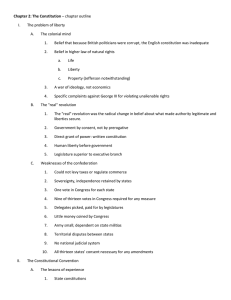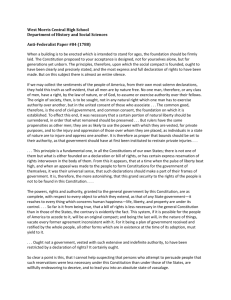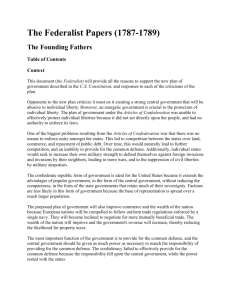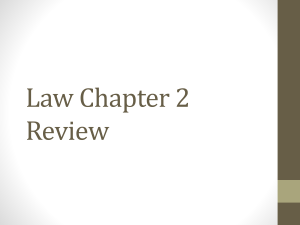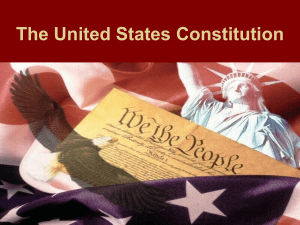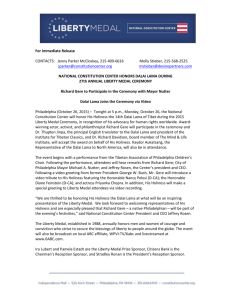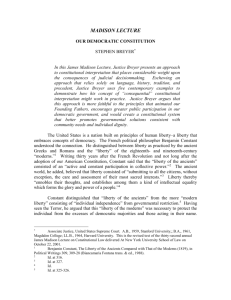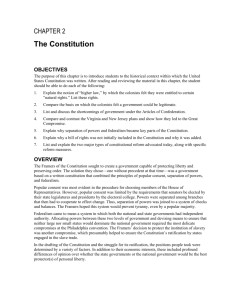ch. 2 guide
advertisement
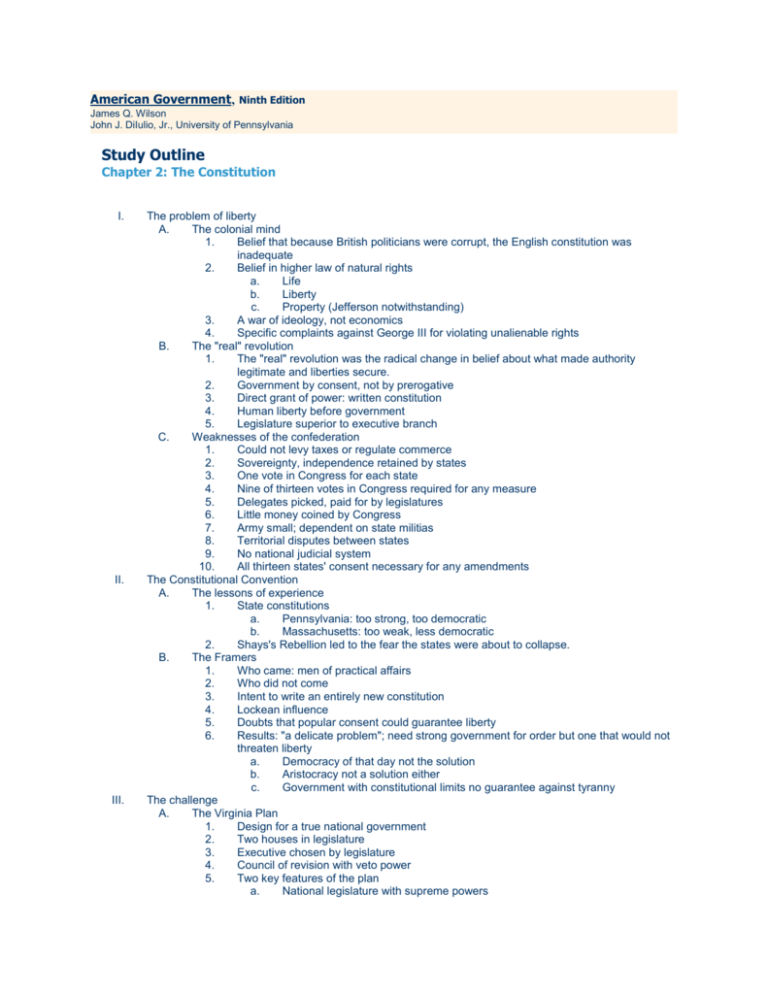
American Government, Ninth Edition James Q. Wilson John J. DiIulio, Jr., University of Pennsylvania Study Outline Chapter 2: The Constitution I. II. III. The problem of liberty A. The colonial mind 1. Belief that because British politicians were corrupt, the English constitution was inadequate 2. Belief in higher law of natural rights a. Life b. Liberty c. Property (Jefferson notwithstanding) 3. A war of ideology, not economics 4. Specific complaints against George III for violating unalienable rights B. The "real" revolution 1. The "real" revolution was the radical change in belief about what made authority legitimate and liberties secure. 2. Government by consent, not by prerogative 3. Direct grant of power: written constitution 4. Human liberty before government 5. Legislature superior to executive branch C. Weaknesses of the confederation 1. Could not levy taxes or regulate commerce 2. Sovereignty, independence retained by states 3. One vote in Congress for each state 4. Nine of thirteen votes in Congress required for any measure 5. Delegates picked, paid for by legislatures 6. Little money coined by Congress 7. Army small; dependent on state militias 8. Territorial disputes between states 9. No national judicial system 10. All thirteen states' consent necessary for any amendments The Constitutional Convention A. The lessons of experience 1. State constitutions a. Pennsylvania: too strong, too democratic b. Massachusetts: too weak, less democratic 2. Shays's Rebellion led to the fear the states were about to collapse. B. The Framers 1. Who came: men of practical affairs 2. Who did not come 3. Intent to write an entirely new constitution 4. Lockean influence 5. Doubts that popular consent could guarantee liberty 6. Results: "a delicate problem"; need strong government for order but one that would not threaten liberty a. Democracy of that day not the solution b. Aristocracy not a solution either c. Government with constitutional limits no guarantee against tyranny The challenge A. The Virginia Plan 1. Design for a true national government 2. Two houses in legislature 3. Executive chosen by legislature 4. Council of revision with veto power 5. Two key features of the plan a. National legislature with supreme powers b. One house elected directly by the people The New Jersey Plan 1. Sought to amend rather than replace the Articles 2. Proposed one vote per state 3. Protected small states' interests C. The compromise 1. House of Representatives based on population 2. Senate of two members per state 3. Reconciled interests of big and small states 4. Committee of Detail The Constitution and democracy A. Founders did not intend to create pure democracy 1. Physical impossibility in a vast country 2. Mistrust of popular passions 3. Intent instead to create a republic with a system of representation B. Popular rule only one element of the new government 1. State legislators to elect senators 2. Electors to choose president 3. Two kinds of majorities: voters and states 4. Judicial review another limitation 5. Amendment process C. Key principles 1. Separation of powers 2. Federalism 3. Popular Sovereignty D. Government and human nature 1. Aristotelian view: government should improve human nature by cultivating virtue 2. Madisonian view: cultivation of virtue would require a government too strong, too dangerous; self-interest should be freely pursued 3. Federalism enables one level of government to act as a check on the other E. The Constitution and liberty F. Whether constitutional government was to respect personal liberties is a difficult question; ratification by conventions in at least nine states a democratic feature but a technically illegal one G. The Antifederalist view 1. Liberty could be secure only in small republics. a. In big republics national government would be distant from people. b. Strong national government would use its powers to annihilate state functions. 2. There should be many more restrictions on government. 3. Madison's response: personal liberty safest in large ("extended") republics a. Coalitions likely more moderate there b. Government should be somewhat distant to be insulated from passions 4. Reasons for the absence of a bill of rights a. Several guarantees in Constitution 1. Habeas corpus 2. No bill of attainder 3. No ex post facto law 4. Trial by jury 5. Privileges and immunities 6. No religious tests 7. Obligation of contracts b. Most states had bills of rights. c. Intent to limit federal government to specific powers H. Need for a bill of rights 1. Ratification impossible without one 2. Promise by key leaders to obtain one 3. Bitter ratification narrowly successful The Constitution and slavery A. Slavery virtually unmentioned B. Apparent hypocrisy of Declaration signers C. Necessity of compromise: otherwise no ratification 1. Sixty percent of slaves counted for representation. B. IV. V. VI. VII. 2. No slavery legislation possible before 1808 3. Escaped slaves to be returned to masters D. Legacy: Civil War, continuing problems The motives of the Framers A. Acted out of a mixture of motives; economic interests played modest role B. Economic interests of framers varied widely 1. Economic interests of Framers varied widely 2. Beard: those who owned governmental debt supported Constitution 3. However, no clear division along class lines found 4. Recent research: state considerations outweighed personal considerations; exception: slaveholders C. Economic interests and ratification 1. Played larger role in state ratifying conventions 2. In favor: merchants, urbanites, owners of western land, holders of government IOUs, non-slave owners 3. Opposed: farmers, people who held no IOUs, slaveowners 4. But remarkably democratic process because most could vote for delegates 5. Federalists versus Antifederalists on ideas of liberty D. The Constitution and equality 1. Critics: government today is too weak a. Bows to special interests b. Fosters economic inequality c. Liberty and equality are therefore in conflict 2. Framers more concerned with political inequality; weak government reduces political privilege Constitutional reform--modern views A. Reducing the separation of powers to enhance national leadership 1. Urgent problems remain unresolved 2. President should be more powerful, accountable, to produce better policies 3. Government agencies exposed to undue interference 4. Proposals a. Choose cabinet members from Congress b. Allow president to dissolve Congress c. Empower Congress to require special presidential election d. Require presidential/congressional terms e. Establish single six-year term for president f. Lengthen terms in House to four years 5. Contrary arguments: results uncertain, worse B. Making the system less democratic 1. Government does too much, not too little 2. Attention to individual wants over general preferences 3. Proposals a. Limit amount of taxes collectible b. Require a balanced budget c. Grant president a true line-item veto d. Narrow authority of federal courts 4. Contrary arguments: unworkable or open to evasion C. Who is right? 1. Decide nothing now 2. Crucial questions a. How well has it worked in history? b. How well has it worked in comparison with other constitutions?
